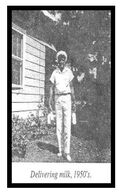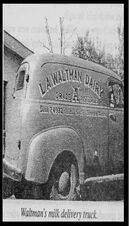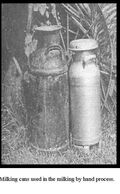|
A steady growth of dairy farms took place from 1915 to the 1970’s when there were approximately 45-50 dairies in the Semmes Area. There are no dairy farms today!
The first commercial dairy farming in Semmes area began in 1915 when Bernice Graham started a dairy on Schillinger Road. He milked his small herd of cows by hand. The milk was strained and stored in five and ten gallon milk cans kept cool when the cans of milk were placed in canvas bags surrounded by cool pump water. The milk was then transported to the creamery plant in Springhill, Alabama where it was processed and distributed to homes and businesses. 1919 Dairy Farmer Roland Graham bottled raw milk (unpasteurized milk) into ½ pints,1 pints and 1 quart bottles and making delivered to businesses, homes, cafes, boarding houses. In the 1920’s electricity began to expand into rural areas making it possible for the construction of an ice plant in the Crawford Community. Dairy farmers began using ice to keep their milk cold. 1930’s Dairy farmers began to grow corn and hay to feed the cows. Commercial Feed stores began feed delivery to dairy farms. 1940 Roland Graham built a Pasteurizing Plant in the Crawford community. The Pasteurizing plant was sold to Barbers Dairy in 1950. As electricity became available to outreaching rural areas, there was a change from hand milking to electric milking machines. 1940 Lewis Waltman built his own pasteurization plant and bottle milk from his dairy. He purchased a truck and delivered milk to homes, business. In 1960 he sold his pasteurizing plant to Van Antwerp. And his milk route to Barbers Dairy. Personal note! When I was around 4 year old we had a cow named Bessie to provide milk for our family. One day my mother heard me screaming at the top of my lungs out in the barn. She ran as fast as she could to the barn. Entering the barn she saw I was safe in Bessie stall and Bessie was on the outside looking at me wondering why I was screaming. Needless to say, I did not play in the barn again, or go near a cow. My next up close experience with a cow was many years later when we were living at the Byrd family home place. My father in law decided to buy a milk cow to keep on the home place. He was a pastor living in a local church parsonage and asked if I would be willing to milk the cow for half of the milk. Our children were small so I agreed, and amazingly I learned to milk. The milk was rich and delicious with cream on top. " Scrapbook of Memories," 1996
0 Comments
 Early settlers had to be very resourceful, creative, inventive people. Resources were very limited to the tools, items they brought with them. When something broke it had to be repaired or a new one made from bar stock of iron or steel. An important person in the early settlement was the blacksmith. He was a skilled craftsman, who heated iron to shape it, using a forge, anvil, hammers, tongs, chisels and punches to create, repair, and make needed metal items. With a vise and files, he refined the rough edges. A forge (furnace) burning coal was used to heat iron placed in the forge to a high temperature. The temperature of the forge was controlled by air being pumped into the forge using large leather bellows, the more air the faster the coal burns, the higher the temperature. Color changes in the metal indicate when the metal was ready to be worked. It was taken out of the fire and hammered on an anvil until the desired shape or repair was achieved. The reheat process is repeated until the desired shape, repair or weld was made. It was then dipped in a tub of water or oil to cool quickly or slowly to the desired temper of hardness. Allentown had a blacksmith shop that was located at the corner of Wulff and Howells Ferry Road. (Allentown was a town with a church, school, store, cemetery and blacksmith shop that was named for the Allen families who homesteaded in 1820. The only thing that remains today is the Allentown Cemetery and Allentown Holiness church) Semmes blacksmith shop was located at the corner of Wulff and Hwy 98, just north of the Tift-Pringle grocery store. The shop was owned and operated by Mr. Wulff. Horses and mules were shod, and all types of agricultural equipment were kept in repair. Knives and other useful items were made. Russell Wulff would later build a home and operate a grocery store at this location. Today in 2019, Walgreen’s Drug Store occupies this property. |
SemmesPreserving our History Archives
November 2023
|




 RSS Feed
RSS Feed